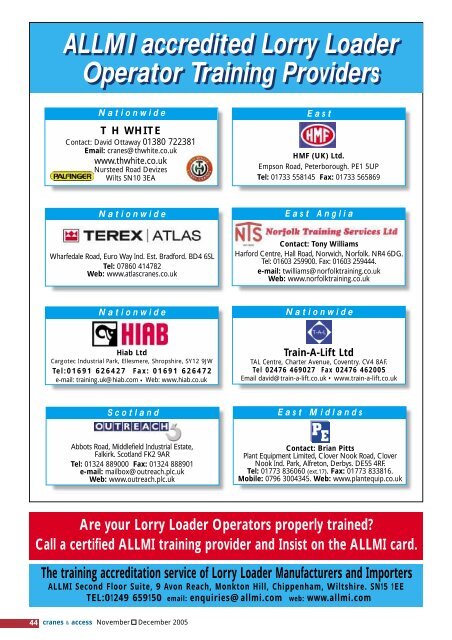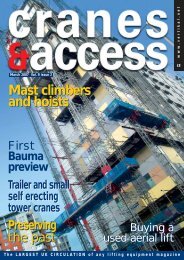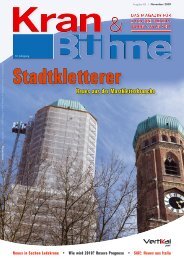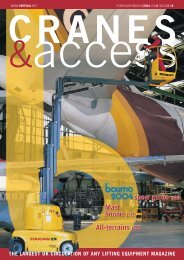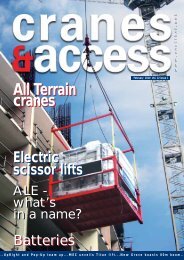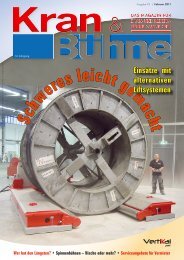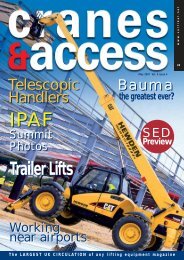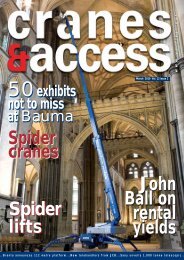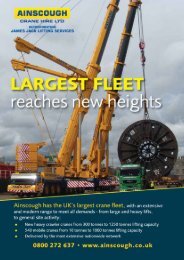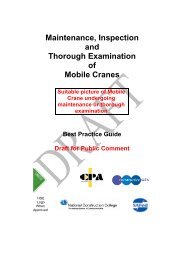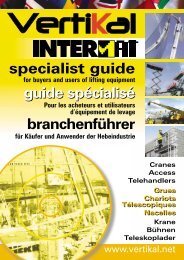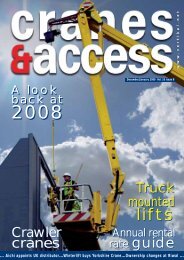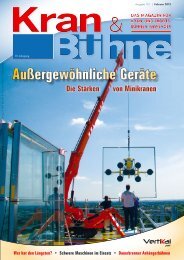ALLMI accredited Lorry Loader Operator Training Providers ALLMI ...
ALLMI accredited Lorry Loader Operator Training Providers ALLMI ...
ALLMI accredited Lorry Loader Operator Training Providers ALLMI ...
Create successful ePaper yourself
Turn your PDF publications into a flip-book with our unique Google optimized e-Paper software.
<strong>ALLMI</strong> <strong>accredited</strong> <strong>Lorry</strong> <strong>Loader</strong><br />
<strong>Operator</strong> <strong>Training</strong> <strong>Providers</strong><br />
Nationwide<br />
T H WHITE<br />
Contact: David Ottaway 01380 722381<br />
Email: cranes@thwhite.co.uk<br />
www.thwhite.co.uk<br />
Nursteed Road Devizes<br />
Wilts SN10 3EA<br />
Nationwide<br />
Wharfedale Road, Euro Way Ind. Est. Bradford. BD4 6SL<br />
Tel: 07860 414782<br />
Web: www.atlascranes.co.uk<br />
Nationwide<br />
Hiab Ltd<br />
Cargotec Industrial Park, Ellesmere, Shropshire, SY12 9JW<br />
Tel:01691 626427 Fax: 01691 626472<br />
e-mail: training.uk@hiab.com • Web: www.hiab.co.uk<br />
The training accreditation service of <strong>Lorry</strong> <strong>Loader</strong> Manufacturers and Importers<br />
44 cranes & access November December 2005<br />
East<br />
East Anglia<br />
Contact: Tony Williams<br />
Harford Centre, Hall Road, Norwich, Norfolk. NR4 6DG.<br />
Tel: 01603 259900. Fax: 01603 259444.<br />
e-mail: twilliams@norfolktraining.co.uk<br />
Web: www.norfolktraining.co.uk<br />
Scotland East Midlands<br />
Abbots Road, Middlefield Industrial Estate,<br />
Falkirk. Scotland FK2 9AR<br />
Tel: 01324 889000 Fax: 01324 888901<br />
e-mail: mailbox@outreach.plc.uk<br />
Web: www.outreach.plc.uk<br />
HMF (UK) Ltd.<br />
Empson Road, Peterborough. PE1 5UP<br />
Tel: 01733 558145 Fax: 01733 565869<br />
Nationwide<br />
Train-A-Lift Ltd<br />
TAL Centre, Charter Avenue, Coventry. CV4 8AF.<br />
Tel 02476 469027 Fax 02476 462005<br />
Email david@train-a-lift.co.uk • www.train-a-lift.co.uk<br />
Contact: Brian Pitts<br />
Plant Equipment Limited, Clover Nook Road, Clover<br />
Nook Ind. Park, Alfreton, Derbys. DE55 4RF.<br />
Tel: 01773 836060 (ext.17). Fax: 01773 833816.<br />
Mobile: 0796 3004345. Web: www.plantequip.co.uk<br />
Are your <strong>Lorry</strong> <strong>Loader</strong> <strong>Operator</strong>s properly trained?<br />
Call a certified <strong>ALLMI</strong> training provider and Insist on the <strong>ALLMI</strong> card.<br />
<strong>ALLMI</strong> Second Floor Suite, 9 Avon Reach, Monkton Hill, Chippenham, Wiltshire. SN15 1EE<br />
TEL:01249 659150 email: enquiries@allmi.com web: www.allmi.com
TheLife<br />
c&a<br />
Expectancyofa ofa<br />
<strong>Lorry</strong> <strong>Loader</strong><br />
As with all types of mechanical handling equipment, <strong>Loader</strong><br />
cranes do not last forever and life expectancy should be a key<br />
consideration when buying either a new or second hand crane.<br />
A <strong>Loader</strong> crane is designed around the fatigue life of the materials used<br />
in its manufacture and the life expectancy of the equipment can be<br />
expressed in terms of load cycles. <strong>Loader</strong> crane designs fall into three<br />
categories, which are dependent on their mode of operation and with<br />
each having different life expectancies in terms of load cycles.<br />
Loading Typical Average Full rated<br />
Group operation load cycles load cycles<br />
B2 Hook Duty 60,000 20,000<br />
B3 Grab or Bucket 200,000 60,000<br />
B4 Timber or Scrap 600,000 200,000<br />
A method for calculating the<br />
remaining life of a loader crane<br />
is shown below, using Brick and<br />
Block application. It is worth noting<br />
that loader cranes equipped for<br />
bucket or grab operation will almost<br />
certainly have performed a much<br />
greater number of load cycles than<br />
a crane equipped with just a hook.<br />
While the formula below is a useful<br />
means of estimating the remaining<br />
life of a crane, it is not an exact<br />
science, many of the load cycles<br />
completed will have been less than<br />
fully rated, and a truck is often not<br />
fully loaded. There are though,<br />
systems available which provide<br />
a more accurate calculation.<br />
Data acquisition (Data Monitoring<br />
/logging) systems are available<br />
which store information about the<br />
lifting duties that the crane has<br />
been subjected to in terms of<br />
percentage of rated capacity used<br />
and number of lifts performed. This<br />
enables the remaining life of the<br />
crane to be calculated more<br />
accurately. The data can then be<br />
downloaded and analysed by the<br />
manufacturer. The use of such<br />
systems obviously provides<br />
additional safety for the users as<br />
the correct time to replace the<br />
machine can be more accurately<br />
determined. It can also help to<br />
identify whether the crane being<br />
used is too small or, too big for the<br />
job it is performing. This information<br />
can be invaluable to crane hirers,<br />
allowing them to examine the<br />
usage to which the crane has<br />
been put by each customer.<br />
However, when calculating life<br />
expectancy, even with data<br />
monitoring, other factors come into<br />
play. The remaining life expectancy<br />
is partly dependent on the quality<br />
of the crane’s service history. This<br />
issue was discussed on this page<br />
in the October edition, highlighting<br />
how operator training can be an<br />
important factor. In fact, the<br />
operator’s ability to look after the<br />
crane doesn’t only apply to basic<br />
preventative maintenance, but also<br />
the way in which the equipment is<br />
operated. For example, a key part of<br />
an <strong>ALLMI</strong> training course is to stress<br />
the importance of lifting loads with<br />
the correct boom geometry. Where<br />
this is not performed, the operator<br />
may overload either the inner or<br />
outer boom cylinders, which is<br />
detrimental to the life of the crane.<br />
In fact, when buying a used loader<br />
crane it might be prudent to<br />
investigate the training level of its<br />
operators, as badly trained operators<br />
may affect any pre-purchase life<br />
expectancy calculations.<br />
Example of life<br />
expectancy calculation<br />
The following example demonstrates<br />
the method for calculating the<br />
remaining life of a loader crane<br />
using Brick and Block application:<br />
Crane 10 Tonne/metre crane<br />
Crane class B3, 60,000 full load cycles<br />
Chassis 26 Tonne GVM (GVW)<br />
Chassis 7250kg kerb weight<br />
Body 1000kg<br />
Subframe 300kg<br />
Grab and Rotator 300kg<br />
Age of <strong>Loader</strong> 5 Years<br />
Weight of Brick Pack 1100kg<br />
Working days per Year 260 days<br />
This example assumes that the<br />
vehicle is loaded with a fork truck<br />
and that two full trips are made<br />
every working day. Be aware that<br />
if a lorry self loads, as well as off<br />
loads, then the number of load cycles<br />
will be double that shown. Each<br />
load is considered a full rated load.<br />
It should also be noted that a number<br />
of other operational and demographic<br />
factors could further influence the<br />
accuracy of the calculation.<br />
Step One<br />
Add all the component weights<br />
of the vehicle and subtract<br />
from the GVW to obtain the<br />
vehicle’s Payload.<br />
Chassis kerb (inc. fuel)<br />
Weight<br />
7250kg<br />
Crane 1500kg<br />
Body 1000kg<br />
Subframe 300kg<br />
Grab + Rotator 300kg<br />
Total 10350kg<br />
Gross Vehicle Weight 26000kg<br />
Payload 15650kg<br />
<strong>ALLMI</strong> focus<br />
Step Two<br />
To calculate the maximum number<br />
of packs of bricks the vehicle can<br />
carry. Divide the Payload figure by<br />
the weight of a single pack of bricks.<br />
15650<br />
1100<br />
= 14 Packs<br />
Step Three<br />
To calculate the number of packs<br />
carried in one day. Multiplythe<br />
maximum number of packs that<br />
can be carried by the maximum<br />
Number of trips made per day.<br />
14 x 2 = 28 Packs per day<br />
Step Four<br />
To calculate how many fully rated<br />
load cycles that the crane would<br />
have expended during its life.<br />
Multiply the number of packs<br />
carried per day, by the number of<br />
working days in a year, and the<br />
age of the loader crane in years.<br />
28 Packs a day x 260 days a year x<br />
5 years = 36,400 completed cycles<br />
Step Five<br />
Calculate the remaining load cycles<br />
by subtracting completed load<br />
cycles from total number of fully<br />
rated load cycles as specified in the<br />
loader cranes loading group, i.e. B3<br />
60,000 – 36400 = 23600 cycles<br />
remaining<br />
Step Six<br />
To calculate the maximum life<br />
remaining in the loader crane.<br />
Divide the number of fully rated<br />
load cycles remaining bythe<br />
number of packs carried per year.<br />
23600<br />
= 3.2 years life remaining<br />
28x260<br />
November December 2005 cranes & access<br />
45


